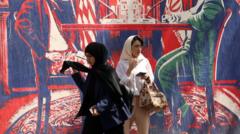Iran's uranium enrichment process has intensified significantly, as detailed in a confidential report by the International Atomic Energy Agency (IAEA) seen by the BBC. Current estimates indicate that Iran’s stockpile of uranium enriched to a purity of 60% has surpassed 400 kg—a notable increase of nearly 50% within just three months. This level of enrichment is typically considered to be on the verge of weapons-grade, with the potential to yield enough material for approximately 10 nuclear weapons if further refined.
The IAEA's Director General, Rafael Grossi, expressed "serious concern" over Iran's escalated production rates, which have reached the equivalent of roughly one nuclear weapon per month. This alarming development occurs amidst ongoing nuclear negotiations between Tehran and Washington, raising significant questions about the nature of Iran's nuclear intentions, which the country has repeatedly stated are peaceful.
Despite these reassurances, the IAEA has indicated its inability to verify such claims. The report suggests that Iran may be in violation of its non-proliferation commitments, prompting the U.S., Britain, France, and Germany to consider pushing for formal actions against Iran through the IAEA's board of governors. In response to the IAEA's findings, Israeli officials expressed strong denunciations, indicating that Iran is "totally determined" to acquire nuclear capabilities, asserting that the current enrichment levels have no civilian justification.
In a televised address, Iranian Foreign Minister Abbas Araghchi maintained that Tehran views nuclear weapons as "unacceptable." Nevertheless, U.S. officials estimate that if Iran opts to pursue creating a nuclear weapon, it could generate weapons-grade material in under two weeks, building a bomb within a few months thereafter.
The report also revisits Iran's clandestine nuclear activities, disclosing secret operations that took place until the early 2000s at unknown sites in Lavisan-Shian, Varamin, and Turquzabad. As negotiations between Iran and the U.S. have been ongoing since April, a myriad of issues continue to divide the parties, particularly regarding Iran's capability to maintain its enrichment processes under any future agreements.
Both sides show cautious optimism about reviving the nuclear deal, yet the growing scale of Iran's enrichment prompts unease among Western nations, particularly in light of hints from Iranian officials suggesting a potential reevaluation of the nation’s resistance to developing nuclear weapons under external pressure. The IAEA is scheduled to convene soon to deliberate next steps amid increasing calls for Iran to cooperate fully with its inspection mandates and adhere to nuclear non-proliferation standards.
Consequently, the report's implications may lead Iran to be brought before the UN Security Council, an action that could arise in subsequent IAEA board meetings as international scrutiny intensifies.
















